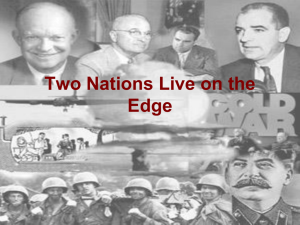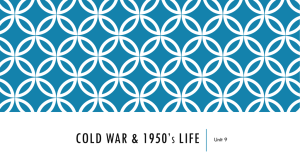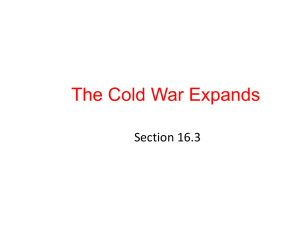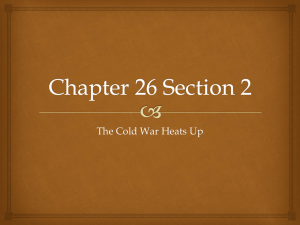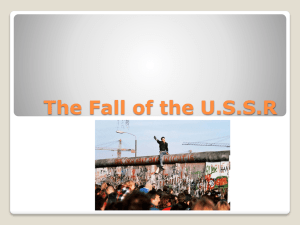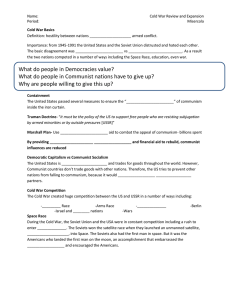File
advertisement
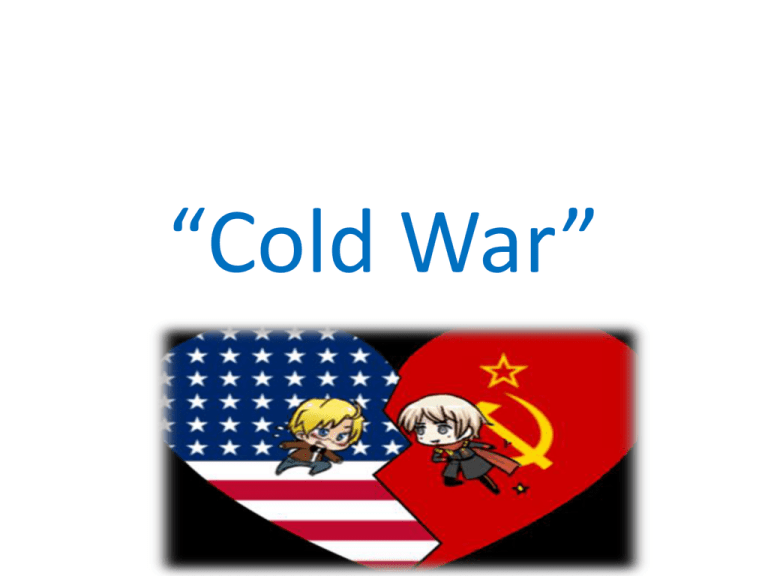
“Cold War” 20-1 • Stalin feared the capitalist West and the West feared communism. • Once the Axis Powers were defeated, the U.S. and Soviets became enemies. • The Soviet Union maintained a military force in Eastern European countries to keep them from electing to be anti- soviet • Communist Peoples’Liberation Army and anticommunists(supported by the British) fought in Greece for control in 1946. • Britian’s withdrawal from the War in 1947, lead to the U.S. stepping in. • Money was given to countries fighting communism thanks to the Truman Doctrine 20-1 • Dean Acheson – U.S. secretary of state coined the “one bad apple can spoil the whole barrel” phrase. • 1947 The Marshall Plan – (European Recovery Program) proposed by General George Marshall. • Marshall Plan gave $13 billion in aide to Europe • Satellite states were countries controlled by the Soviets • the Council for Mutual Economic Assistance (COMECON) was founded by the Soviets in 1949 • Soviets didn’t have enough money. • Policy of Containment became the new policy 20-1 • Germany was split into ¼ between the U.S., Soviet Union, Great Britain, and France. • Berlin in Soviet territory was also divided. • Allies wanted Berlin to have a W. German Govt. • Soviets blocked food to 2.5 million Berlin residents • Berlin Air Lift consisted of 2.3 million tons of supplies : • - 10 months • - 200k flights • 1949 Federal Republic of Germany (or W. Germany) • German Democratic Republic (E. Germany) Spread of the Cold War • • • • • • • • • Communism took over China 1949 – Soviets explode their first atomic bomb. U.S. and Soviets start an arms race. April 1949 NATO (North Atlantic Treaty Organization) good guys pg. 633/634 1955 Warsaw Pact between the bad guys Expansion with Korean war led to new pacts” SEATO – Southeast Asia Treaty Organization CENTO – Central Treaty Organization U.S. was aligned with 42 countries around the world Arms Race • The Hydrogen bomb developed in the 1950’s by United States and Soviet Union • ICBM – intercontinental ballistic missile • Deterrence- huge weapons prevented both from attacking • 1957 Sputnik 1 went into orbit! First human man made Satelite • 1955 Nikita Khrushchev built a wall in Berlin to keep E. Germans from leaving. • 1961- August E. German government built a wall to separate East and West Germany Cuba • Fidel Castro overthrew Fulgencio Batista as the Cuban Dictator • 1959 Fidel Castro took over Cuba and installed a Soviet-supported totalitarian regime. • Kennedy approved “Bay of Pigs” • 1962 Khrushchev sends over nuclear missiles to Cuba after the U.S. put them in Turkey • U.S. blocks ships carrying weapons the 2 countries reach an agreement. Vietnam • 1964 L.B.J sent troops to Vietnam to keep the North communist from taking over the South. • Domino theory – If the south fell it would spread to other countries • First conflict to get real time press • 1973 – Nixon reached an Agreement with North and withdrew U.S. troops • Domino didn’t happen and the U.S. opened relations with China Section 2 Soviet Union/Eastern Europe • Stalin went back to the 1930’s policy to create Industrial base. • Workers were expected to produce exports for very little pay. • 1950’s Heavy industry was in full production- machines and eqiptment for factories • Russians lived in poor conditions (one bed room apart.) • 1946 Govt. controlled all literary and scientific work • Nikita Khrushchev took over the Soviet Union in 1956 • Stalin died on March 5,1953 which prevented more blood letting Soviets • De-Stalinization = loosen govt. control (literary works) • Literary works like “One Day in the Life of Ivan Denisovich” written by Alexander Solzenitsyn became legal. • Changing the industry to farming(corn)bad idea helped to ruin ruined reputation within the party • Industrial growth rate declined from 13 percent to 7.5 percent from the year of 1953 to 1964 • Khrushchev Placed missiles in Cuba (final straw) • 1964 Khrushchev got the boot while on vacation Behind the Iron Curtain • Yugoslavia (Josip Broz) Tito, leader of communism resistance movement • Yugoslavia was communist but not Soviet controlled. • Poland, Hungary, and Czechoslovakia wanted to get out from under Soviet control. • 1956 – Poland acted first but stayed in the Warsaw Pact. • Poland Named Wladyslaw Gomulka the first secretary. • 1956 – Hungary’s leader Imre Nagy declared freedom November 1, 1956. • - 3 days later Soviets attacked Budapest and reestablished control and killed Nagy. Dubcek • 1968 – Alexander Dubcek took over in Czechoslovakia and completely changed the old policies of Novotny (little Stalin) • Dubcek allowed freedom of speech, press, and to travel abroad. • Euphoria broke out in Czech called the Prague Spring. • Euphoria was short lived • 1968 Soviets invaded and crushed Dubcek and replaced him with Gustav Husak. 20-3 • 1947 – 1950 The U.S. gave Western Europe $9.4 Billion for new equipment and raw materials. Thanks to Marshall Plan • 1950s’ Industrial output was above 30 percent and unmemployment was almost at 0 • France – Charles de Gaulle (war hero) established the Fourth Republic • - weak president • - strong parliament • - ineffective • Withdrew from politics because he was unhappy 4th republic • 1958 he started the Fifth Republic with a strong president (Gaulle) • Drafted Constitution for the Fifth Republic 20-3 • De Gaulle made France a superpower and produced multiple nuclear bombs (1960) • West Germany – • 1946-1963 Konrad Adenauer was chancellor (head of the Christian Democratic Union) • United West Germany with the rest of Western Europe • Economic miracle led by Ludwig Erhard minister of Finance • Unemployment went from 8% to 0.4% and “guests” were brought in to work other countries Italy, spain, Greece, Turkey, and Yugo. 20-3 • Great Britain – major problems after WWII Labour Party manhandles Churchhills Conservative Party in the election. • Labour Party takes over creates a “welfare state” • Welfare State- government takes care of everything. • 1946-government goes passed National Insurance Act and National Health Service Act • Socialized medicine-medical care for everyone • Conservative Party back in control but expanded the welfare system. 20-3 • NATO formed in 1949 • 1957 Western European countries signed the EEC (European Economic Community) also known as the Common Market • EEC was a free-trade agreement made up of six countries. • Trading bloc- group of nations with a common purpose • Population of 165 million, made the EEC the largest exporter and Purchaser of raw material 20-3 U.S. • • • • • • • • • 1945-1970 FDR’s New Deal shaped America’s domestic politics - labor unions - Social security Economic Boom after World War 2 thanks to shortage of consumer goods during the war. Real wages (purchasing power) maintained a 3% annual growth 1945-1973 Fear of Communism was widespread Trumans Attorney said that Communist were everywhere? Sen. McCarthy spread the fear “Red Scare” Implying the Army had Communists in charge led to his end. 1960’s • John F.Kennedy (43 yrs old) youngest U.S. president ever Killed 11/22/1963 • Vice Pres. Lyndon B.Johnson became president 1964 by a landslide • LBJ increased funding for Govt. services and cont. the civil rights movement that started 1954 desegregating schools. • LBJ had a Passion for civil rights • Aug. 1963 Martin Luther King, Jr. led a march on Washington D.C. (Gandhi style) 1960’s • 1964 Civil Rights Act – was the beginning to end segregation and discrimination in the workplace and public areas. • 1965 – Voting rights Act- made it easier for African Americans to vote in the south • 1965 Riots broke out in Watts (L.A.) 34 dead, thousands of buildings destroyed. • 1968 M.L.K. assassinated. Riots hurt the civil rights movement. Led to a “white backlash” • Anti war protests increased. 1970 (4) students killed and (9) others wounded at Kent State University. New Society • Middle class is truly created business people, lawyers, doctors, and teachers • Lower class shifted from rural to urban areas • Farming decreased drastically by 1950s • Consumer Society – a society preoccupied with buying goods. • Credit was created • 1948 – 5 million cars • 1960’s – 45 million cars • 1940’s-1950’s “Baby Boom” Soldiers came home from war Women/students • 1960’s Women started back into the work force. • Same work less pay. Still had traditional jobs as well. • Women’s liberation movement-asserting their rights • Simone de Beauvoir wrote “The Second Sex” • Students in the U.S. protested about Vietnam, European students protested for more students to achieve higher education
